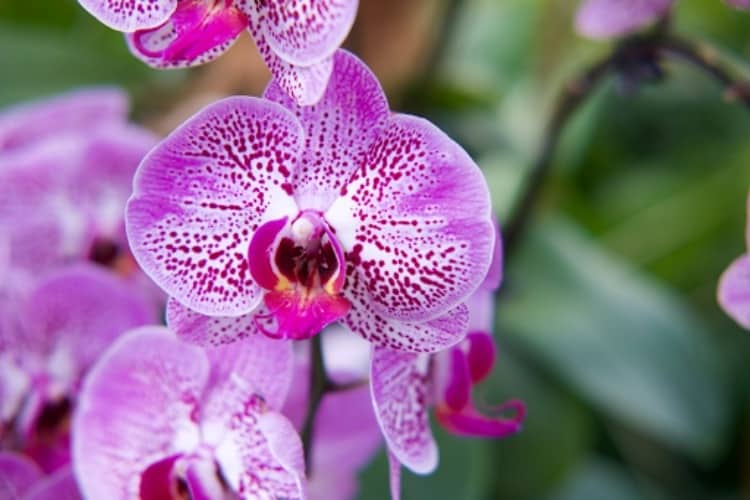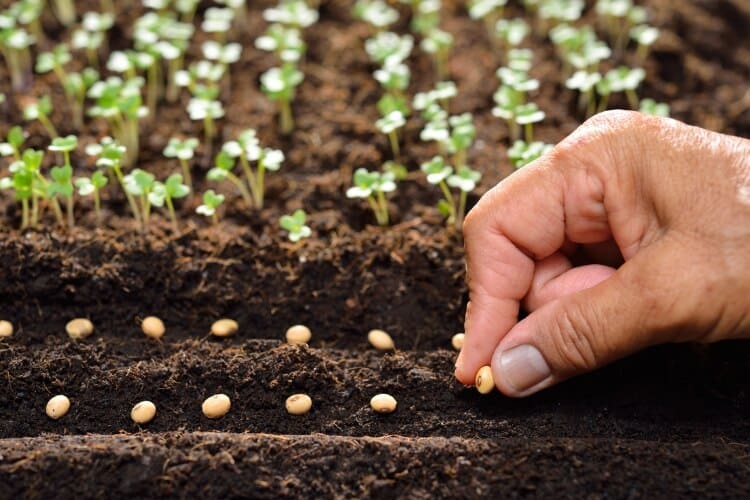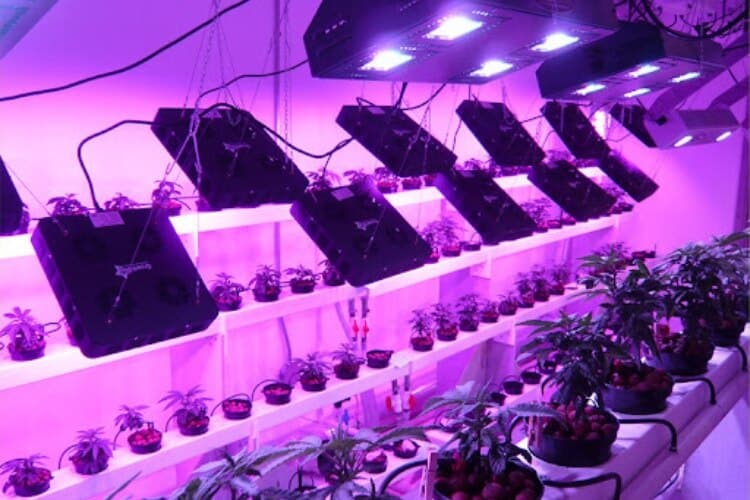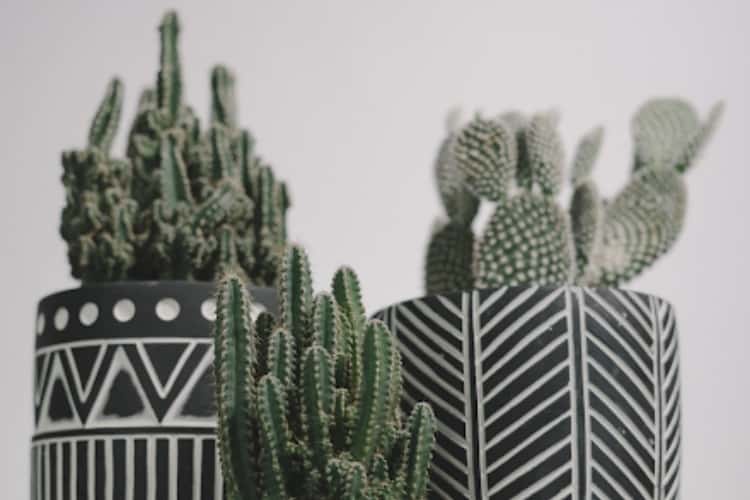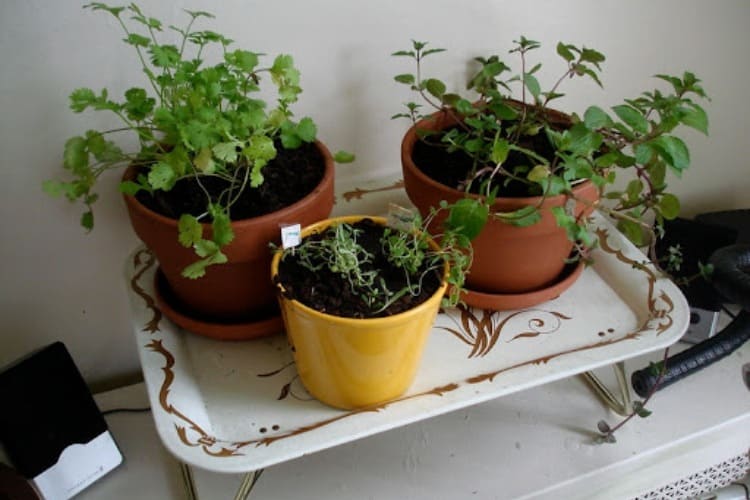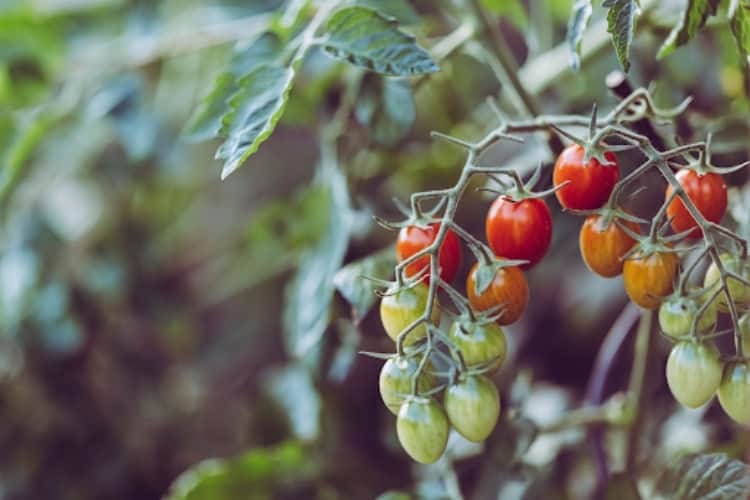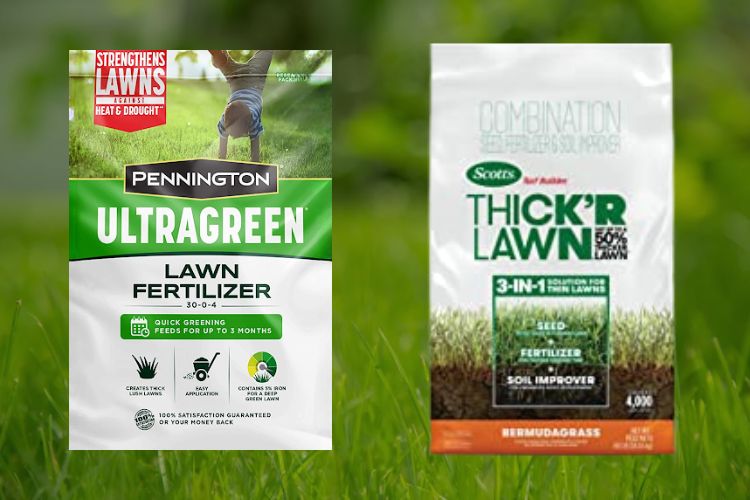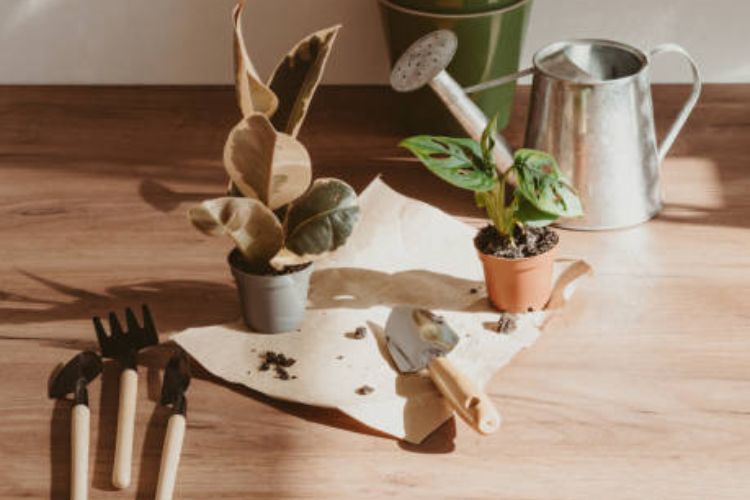The 8 Best Grow Lights For Indoor Plants of 2023
We independently evaluate all recommended products. If you click on links we provide, we may receive a commission. Learn more
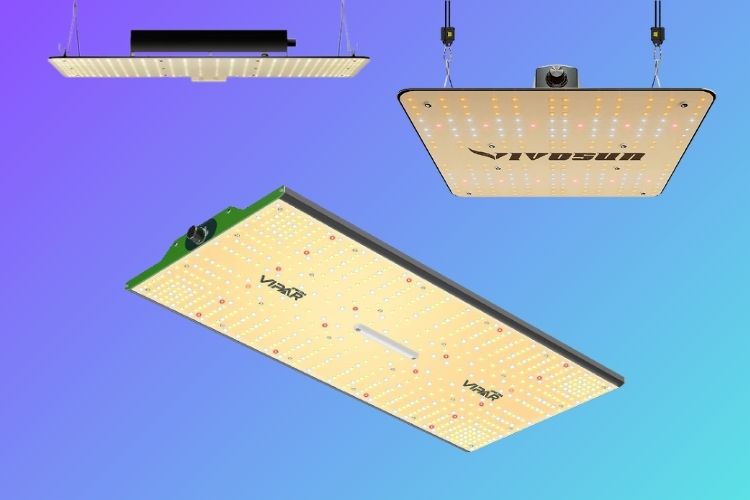
The best grow light for indoor plants has a full spectrum and ensures coverage of your growing space. LEDs and Fluorescent lights both provide enough spectrum and color temperature for each stage of plant growth, from seedling to flowering and fruiting.
Besides, choosing the right wattage also contributes to growth, preventing problems that lead to crop damage such as leaf burn, wilting, or turning yellow. Among a variety of brands and product lines, choosing the best one might make you confused. Refer to the list of 8 best grow lights for indoor plants after I research and select carefully to help you pick the best ones for your garden.
Our Top Picks
- Best Overall: VIVOSUN VS1000E LED Grow Light
- Best Goosenecks: SANSI LED Grow Light
- Best Optimal Power: MEDIC GROW Fold-6 LED Grow Light
- Best Daisy Chain: VIPARSPECTRA Upgraded P2000 LED Grow Light
- Best Low Heat: VEVOR LED Grow Light
- Best Dimmer: GooingTop LED Grow Light
- Best Budget: bseah LED Grow Light
- Best Seedings: SYEIORAOM LED Grow Light
Best Overall: VIVOSUN VS1000E LED Grow Light
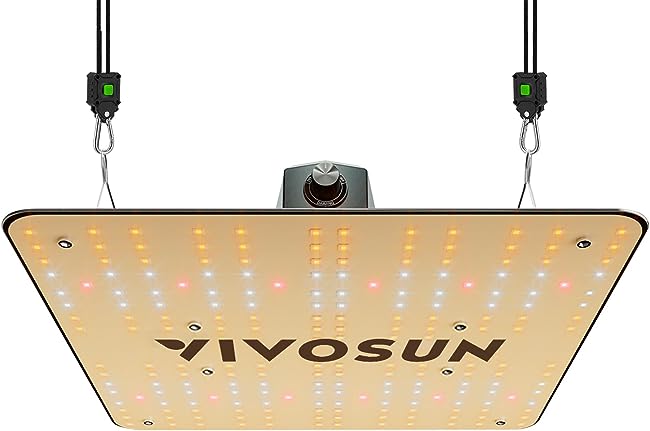
Price at time of publish: $70
| Type | LED |
| Height | 1.6 inches |
| Color | Natural color |
| Full spectrum | Yes |
| Wattage | 100 watts |
The first product I want to introduce to you is the VIVOSUN VS1000E LED grow light. When it comes to VIVOSUN, I am often assured of the quality of the bulbs here.
This LED is combined with Samsung’s diode technology so it really makes a difference in the production process and optimizes light quality for a wide variety of plants in my garden.
In the first days of use, I was really impressed by the bloom of my rose pots thanks to the full spectrum that this LED light brings. In addition, the temperature color level from the VS1000E is similar to sunlight, which promotes my roses to grow faster at night.
My next impression is that the 2 x 2 ft coverage area is close accurate, suitable for small to medium sized indoor gardens. I observed that the plants grew healthier and had denser foliage in the area covered by this light. It’s worth noting that light intensity and spectrum are important factors for successful indoor gardening. Luckily! The VS1000E can meet in both aspects.
Pros
- Samsung diodes
- Full spectrum
- Low heating
- Wide coverage
- Energy efficiency
- Durable
Cons
- Quite expensive compared to other lights
- No dimmer modes
Best Goosenecks: SANSI LED Grow Light
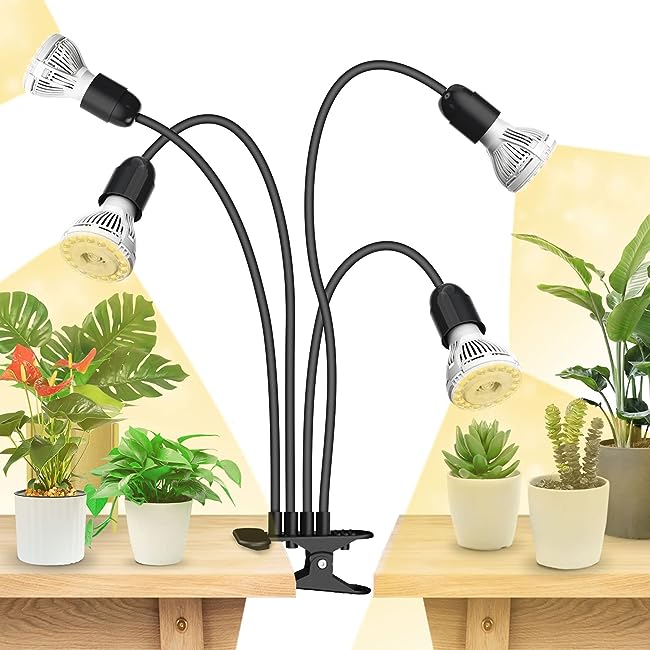
Price at time of publish: $44
| Type | LED |
| Height | 5.51 inches |
| Color | Black |
| Full spectrum | Yes |
| Wattage | 40 watts |
The gooseneck is one form of grow light on my list of favorites because it’s incredibly versatile that allows me to adjust the height and angle of light to suit my plants. This adjustable design is convenient for different types of houseplants with different lighting requirements.
SANSI grow light’s full spectrum provides coverage of all wavelengths required for different growth stages, from seedling to flowering. This is important for indoor gardening, especially during the winter months when natural light is limited.
The standout feature here is the impressive 40W output power equivalent to high PPFD (Photosynthetic Photon Flux Density)1. This capacity is suitable for ornamental plants such as orchids, cacti, monstera, or vegetable plants without worrying about too much heat.
Additionally, in my experience, the timers or the adapters frequently malfunction in devices made by rivals. With SANSI 40W gooseneck grow light, that has not been the case. To power the bulbs, I use a straightforward WIFI plug that I got from Amazon. Using a phone app, I can monitor the lamp’s condition and set its operation hours.
One thing I want to remind you is that its price may be a bit high. However, considering its bulb replacement promise, high PPFD, full spectrum, and bulb replacement, this could be a good choice for a long-term investment.
Pros
- High PPFD output
- Tracking app on mobile
- Gooseneck design
- Full spectrum
- Lifetime bulb replacement warranty
- Affordable price
Cons
- Bit difficult to adjust
- Too hot in some case
Best Optimal Power: MEDIC GROW Fold-6 LED Grow Light
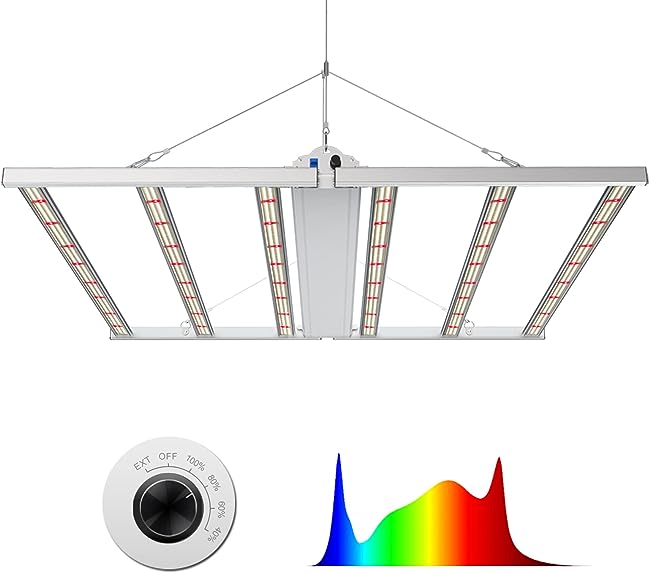
Price at time of publish: $500
| Type | LED |
| Height | 3.44 inches |
| Color | Silver |
| Full spectrum | Yes |
| Wattage | 660 watts |
If you’re looking for a grow light that can help you take your indoor gardening to the next level, the Medic Grow Fold-6 LED is an ideal option. Thanks to the 660W power output and high PPFD, my plants always receive the optimal amount of light for their photosynthesis, even in the dark winter months best.
Another standout feature that I highly recommend this product for is its full spectrum. It can provide the necessary wavelengths for a large garden with light coverage of 4×4 feet area. This is similar to VIVOSUN as it can support diverse crop varieties. Its dimming feature also allows me to freely customize the light intensity for each stage of growth for my potted plants.
However, the price of this Medic Grow Fold-6 LED grow light can be higher, which can be a drawback for gardeners on a limited budget. In addition, the size and weight of the equipment can make installation and positioning difficult, especially for smaller growing spaces.
Pros
- Full spectrum
- Large coverage area
- Light adjustable
- Easy to set up
- High PPFD
Cons
- High price
- Size and weight disadvantage
- Need cooling system in mid of summer
Best Daisy Chain: VIPARSPECTRA Upgraded P2000 LED Grow Light
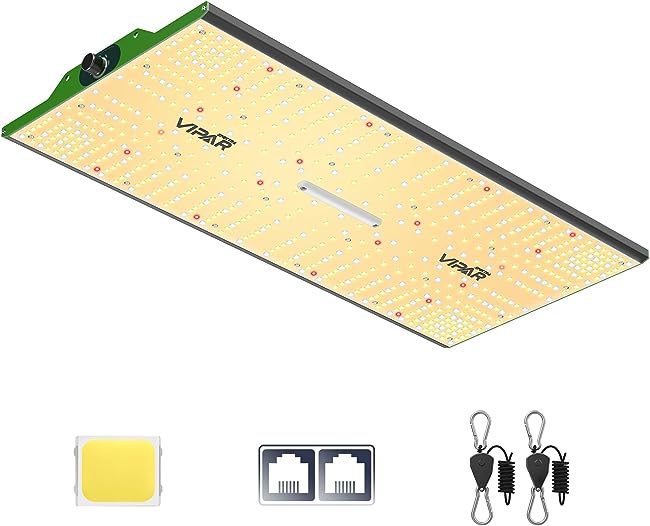
Price at time of publish: $119
| Type | LED |
| Height | 3.2 inches |
| Color | Green |
| Full spectrum | Yes |
| Wattage | 200 watts |
The upgraded P2000 VIPARSPECTRA LED grow light is a reasonable choice for experienced indoor gardeners. Initially, the 200W capacity of this product made me quite hesitant, but overall the value made me decide to try it.
After a period of use, I noticed that my seedlings grew quite quickly and healthy over time. Additionally, its light runs relatively cool compared to CMH or HPS lights I’ve used, and the aluminum fins seem to work well and are easy to clean, too. So I’m very happy with my purchase and bought another one.
The coverage of the P2000 can be for 4×2 ft or 3×3 feet of growing space. It ensures quality light distribution and promotes more uniform growth of my seedlings. Additionally, the daisy chain design simplifies multi-light setups, making it effective for larger indoor gardens. It’s a boomer! There is no daisy link function. For most brands, all have these functions for just a little extra.
Energy efficiency is another plus. You know, the power of LEDs is common in consuming less electricity, which saves me a lot of money2.
Pros
- Daisy chain function
- Save electric energy
- Light adjustable
- Full spectrum
- Good bright for start seeds
- Easy to install
Cons
- Ballast gets really hot in a short time
- Only daisy chain the dimmer, not power
- No timer switch
- High price
Best Low Heat: VEVOR LED Grow Light
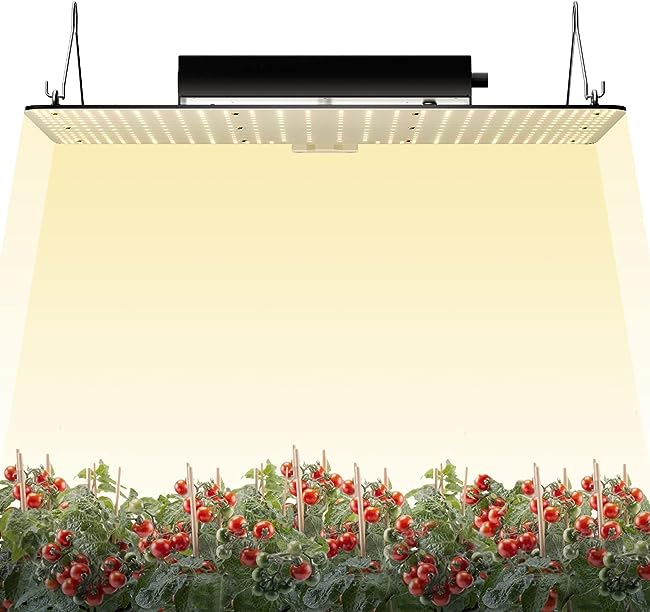
Price at time of publish: $129
| Type | LED |
| Height | 3.1 inches |
| Color | Black |
| Full spectrum | Yes |
| Wattage | 200 watts |
The VEVOR LED Grow Light Samsung 281B+PRO chip is a good grow light that I won’t have to replace in a year or two. Like VIVOSUN, VEVOR also uses Samsung diodes which must mean they have high quality and dependability. These chips also promise a robust growth garden.
As you may expect from an LED panel this big, it delivers a lot of light and can basically turn a room from night into day, to the extent that turning on/off the ceiling lights makes no visible difference. Additionally, its spectrum is great for photographing your plants because it appears to be quite close to natural light. It also covers a wider area than standard farm lights, allowing for better coverage for slightly spread out crops.
Additionally, the daisy chain driver simplifies multi-light setup, a convenient feature for those expanding their indoor gardening efforts. But, it is pricy for a grow light while it does not have many functions, such as timer functions, spectrum adjustments, or remote controls so it is essentially a basic light unit. So, please consider when weighing the costs and benefits!
Pros
- Samsung diodes and PRO chips
- Low heat
- Large coverage area
- Full spectrum
- Daisy chain driver
- Energy efficiency
Cons
- Not many functions
- Need a fan support
- High price
Best Dimmer: GooingTop LED Grow Light
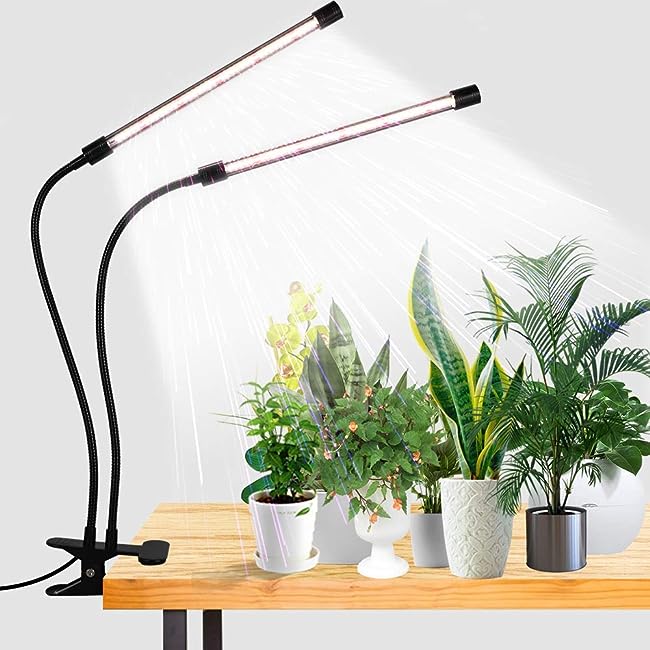
Price at time of publish: $27
| Type | LED |
| Height | 7.9 inches |
| Color | Black |
| Full spectrum | Yes |
| Wattage | 10 watts |
If you’re looking for a desk grow light, I really want to suggest Gooingtop. The clamp design is really convenient and saves space. You can easily attach it to different surfaces, making it suitable for small-scale indoor gardening setups.
What I really like is being able to use both white and red LEDs in its full spectrum. The 6000K spectrum is close to natural sunlight, making it ideal for promoting plant growth, while red LEDs enhance the flowering and fruiting stages. Therefore, you can take care of many different plants under one small lamp.
The dimmability feature is a valuable asset. It has up to 5 different brightness settings, and timer options as well. I successfully used it to grow my microgreens, herbs, beans, and tomato seedlings in a spare bedroom before it was time to transplant them outside. The automatic on/off timer function is also extremely convenient for busy gardeners. It ensures that your plants receive a steady light cycle, even if you can’t control it manually.
However, the wattage of this Gooingtop light is only 10 watts, which is not ideal for larger growing spaces or for plants with particularly high light requirements.
Pros
- Both white and red spectrum
- Dimmable
- Easy to adjust
- Clamp design
- Energy efficiency
- Affordable price
Cons
- Just can use for small space
- Low power for some plant types
- Limit gooseneck length
Best Budget: bseah LED Grow Light
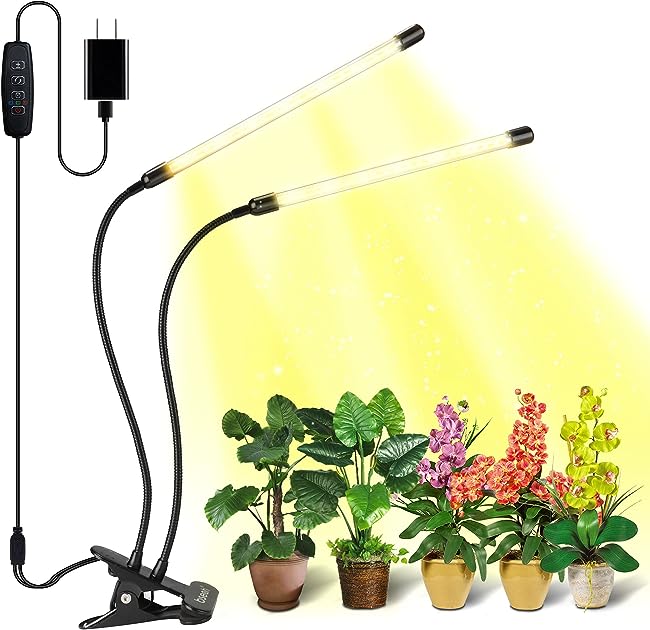
Price at time of publish: $13
| Type | LED |
| Height | 3.5 inches |
| Color | Black |
| Full spectrum | Yes |
| Wattage | 10 watts |
This is the same product as Gooingtop with a flexible clamp design, but more prominent, the bseah grow light has the ability to adjust the brightness up to 10 levels, allowing you to create the best light for your plants growth.
I tried growing succulents and cacti under its yellow light, but the results were fine and didn’t overheat, nor did the plugs overheat or melt. If they were full spectrum white, I would buy them again without thinking.
The auto on/off timer function, with three options for 3, 9, and 12 hours is one of the noticeable benefits of gardening routine. It ensures that your plants receive the right amount of light and avoid burning plants due to exposure too long.
However, the fact that this LED bulb may not be suitable for larger grow spaces or for plants that need high light requirements. For sure!
Pros
- 10 dimmable level
- Easy to adjust
- Clamp design
- Energy efficiency
- Suitable for small plants
- Affordable price
Cons
- Just can use for small space
- Low power for some plant types
Best Seedings: SYEIORAOM LED Grow Light
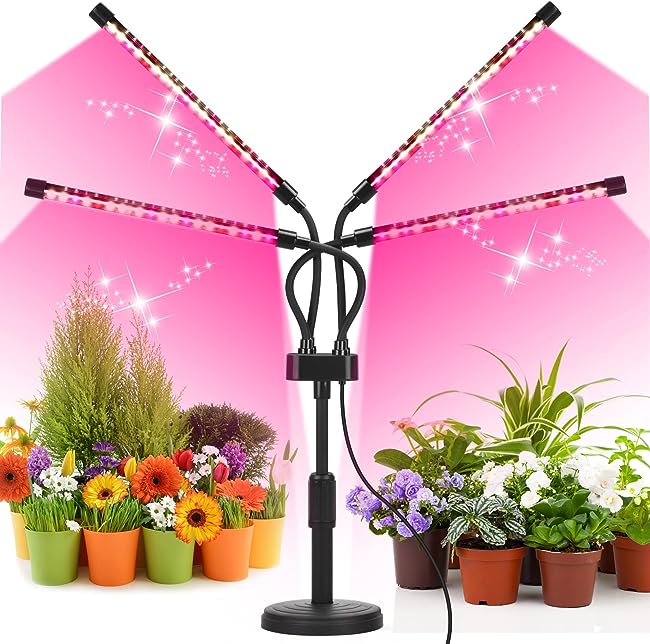
Price at time of publish: $24
| Type | LED |
| Height | 2.5 inches |
| Color | Red and white |
| Full spectrum | Yes |
| Wattage | 10 watts |
Most of the products at the end of my list will lean towards the gooseneck design. As I said, this type of grow light allows anyone to freely adjust the light direction, along with its compact design.
During the search process, I accidentally found this SYEIORAOM LED light that was also in the top Amazon Choice with many ratings. After buying it to try, I was really impressed to see it worked so well on my orchids. Surprising! 5 of my 8 orchids pot had new leaf growth starting within the first week of using it.
More interesting, its four separate light heads fixture provides ample coverage for a variety of plants within a small to medium-sized indoor garden. I can adjust each head individually to enhance its versatility further.
As Bseah or Gooingtop, SYEIORAOM wattage is weak for plants that need stronger light in my home garden.
Pros
- Four adjustable head-light
- Full spectrum
- Clip-on design
- Suitable for seedlings and small plants
- Energy efficiency
- Affordable price
Cons
- Does not have a timer
- No instructions/information with product
- Just can use for small space
Best Grow Lights For Some Type Of Plants
Full spectrum (5000K – 6500K) bulbs are the best choice for indoor plants because they are able to mimic natural light, helping to enhance the light of the home garden on winter months or at night when there is no sunlight.
Here are the experiments we have performed with many types of plants and their growth results. The purpose of this experiment is to help gardeners choose the right type of light for their plants health. Thereby, you can get more knowledge about what are perfect light conditions for the lovely potted plants you are growing.
Pothos
Fluorescent bulbs and LEDs with cool white light output and full spectrum will be the best grow light for all type of Pothos. I tried placing the light fixture with the Pothos at a distance of about 12 inches – 14 inches, and I noticed the foliage grew quite well and became greener.
Monstera
Similar to Pothos, popular houseplants like Monstera also prefer full spectrum light, especially blue and red wavelengths. LED grow lights or fluorescent bulbs will also be good choices for healthy Monstera foliage.
Fiddle-leaf fig
Fiddle leaf fig is a plant that will need green light and full spectrum. Since it is a tree with large foliage, you need to set it further than Pothos and Monstera. Place the fiddle leaf fig under LED or fluorescent lights at a distance of 24 to 36 inches.
Cactus
Cactus always need direct sunlight and thrive under high light intensity. Therefore, full spectrum LEDs would be the perfect choice as they can mimic natural daylight in the desert. Beside, T5 or HID bulbs are also the second choice for Cactus or Succulents.
Herbs
LEDs, HID, and T5 grow lights are suitable for Herbs. Herbs like basil and parsley also grow well under full-spectrum with blue and red wavelengths at all stages of growth.
Orchids
As for Orchids, the experiment shows the versatility of fluorescent and LED bulbs for different types of orchids. I recorded results under the power of these lights about 14-16 hours everyday. Amazing! all orchid pots bloom a lot of flowers in just a few weeks.
How To Choose Best Grow Light For Indoor Plants?
When choosing grow lights for indoor plants, use bulbs with a color temperature level between 5000 and 6500 Kelvin with full spectrum because this light intensity is close to natural light. Check the detail information here:
Types of grow lights
There are many available type of grow lights, from HID, fluorescent, CMH, to LED lights. Take a look in detail below:
- HID (High-Intensity Discharge): HID is combined with Metal Halide (MH) and High-Pressure Sodium (HPS) lights. It produces high-intensity by passing an electric flow between two electrodes through a gas or vapor.
- LED (Light Emitting Diode): I always choose LED lights because it is more energy-efficient than traditional bulbs. You’ll be able to keep your energy costs down while still giving your plants the light they need.
- Fluorescent: Fluorescent is a component of fluorescent tubes and bulbs. Electrodes are positioned on the bulb’s two ends, and they send a current through them.
- CMH (Ceramic Metal Halide): CMH is a combination of HPS and MH lights. Although CMH lights are more effective than standard MH lights, they do not produce as many lights in the red spectrum as HPS.
Size
Next, I advice considering the size of the grow light to know if it is suitable for your growing space, as well as the size of your plants. In other words, the size of the lights directly affects the coverage and light intensity your plants receive.
For example, I am growing tomatoes in a 4×4 foot grow tent. If I choose a light for a 2×2 foot area, it will result in lower light intensity and my plants may not produce as many fruits.
Color temperature and full spectrum
The light spectrum directly affects plant development and its overall health. Red wavelengths is particularly important for stimulating flowering, while blue wavelengths supports vegetative growth.
For color temperature, there are 2 temperature color level:
- Cool white color (5000K-6500K): This color temperature resembles natural sunlight. Therefore, it is rich in blue light to promote healthy leaves and stems during the vegetative phase.
- Warm white (2700K-3000K): This intensity is similar to that of sunrise or sunset since it contains more red blue wavelengths which is important for flowering and fruiting.
Light intensity
This factor affects the rate of photosynthesis in plants. This factor is usually measured by PPFD, which directly affects plant growth and yield.
Wattage
Wattage is the most important factor, because once you choose too high or too low power, it will directly slow down, even destroy your crops. Please check how much wattage the plant you’re in needs before buying.
Low heat
You certainly wouldn’t want your lovely potted plants to burn under the light, right? Choose types of grow lights that emit less heat or have an included cooling system to avoid problems like wilting, leaf burn, or credit growth.
Durable
Choose grow lights that are durable so they can be used over multiple growing seasons as this will save you money and minimize downtime during replacement.
Energy efficiency
Once you have addressed the above factors such as low heat, durability, or choosing the right light source and spectrum, you can use grow lights without fear of your home electricity bill being raised every month.
Note: If the product has an attached cooling system or fan, the possibility of increased operating costs can occur.
Materials
Its depends on what type of material you want. But, that doesn’t mean it’s not necessary!
For example, choosing a light with sturdy materials will ensure that it can withstand the demanding conditions of indoor growing, providing consistent and long-lasting performance. Besides, I always prioritize safety when choosing materials for grow lights.
How Much Do Grow Lights Cost?
The price of grow lights depends on factors such as type, size, and features. Lamps like CFL, T5 and some medium quality LEDs will cost between $100 and $300, while high quality LEDs for larger spaces can cost between $500 and $1500 or more.
Where To Buy?
I usually buy grow lights from online retailers like Amazon and eBay, or specialized gardening stores. But I’d also recommend the manufacturer’s website, local garden centers and niche online marketplaces.
What Should I Consider Before Buying A Grow Light?
- Grow space: It is essential to consider your growing space before purchasing as it will tell you the light coverage, intensity, location and ensure it will not take up all of your garden space.
- Type of plants: Each different type of plant will require different wattage, light output, spectrum or temperature color. Choosing the right or wrong type of grow light will decide the plant’s growth or destruction.
- Budget: Consider weighing your books before choosing the right lamp. Choose the lights that are both functional and affordable. I am also interested in the shipping cost and the possibility of expanding it in the future also related to the financial plan when buying.
- Warranty: Warranty policy will guarantee the quality and durability of the product. I often choose brands with long warranties and free lifetime replacements, such as SANSI.
Conclusion
In general, LED grow lights are always the priority choices of gardeners because they emit enough full spectrum that plants need to grow. Above 8 best grow lights are all LED bulbs with a variety of designs, features, areas and come from reputable brands on the market today.
I am a fan of VIVOSUN and this is also the light brand I would recommend because its quality is worth the price. I’ve also bought and used some of their other devices and the results really exceeded expectations. I also hope the buying guide I shared will help you be more confident in your purchasing decision, ensuring a long-term investment in your gardening career.
FAQs
References


